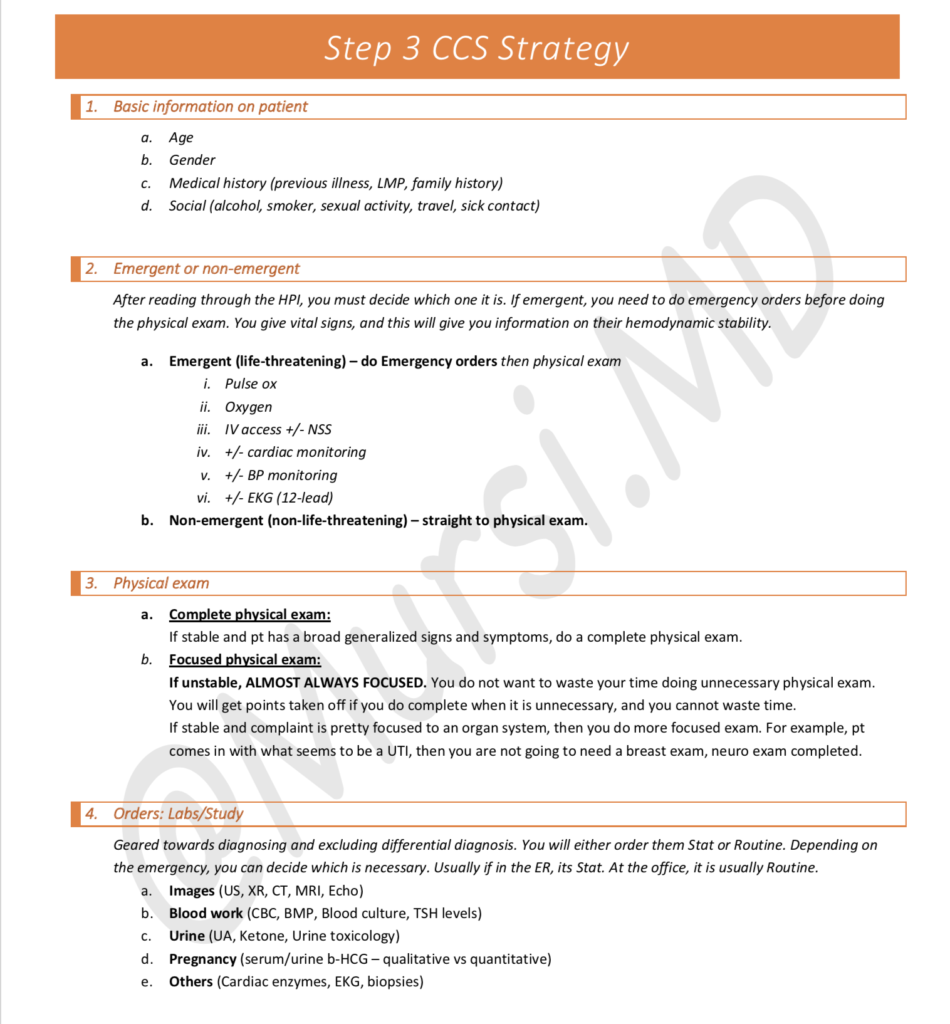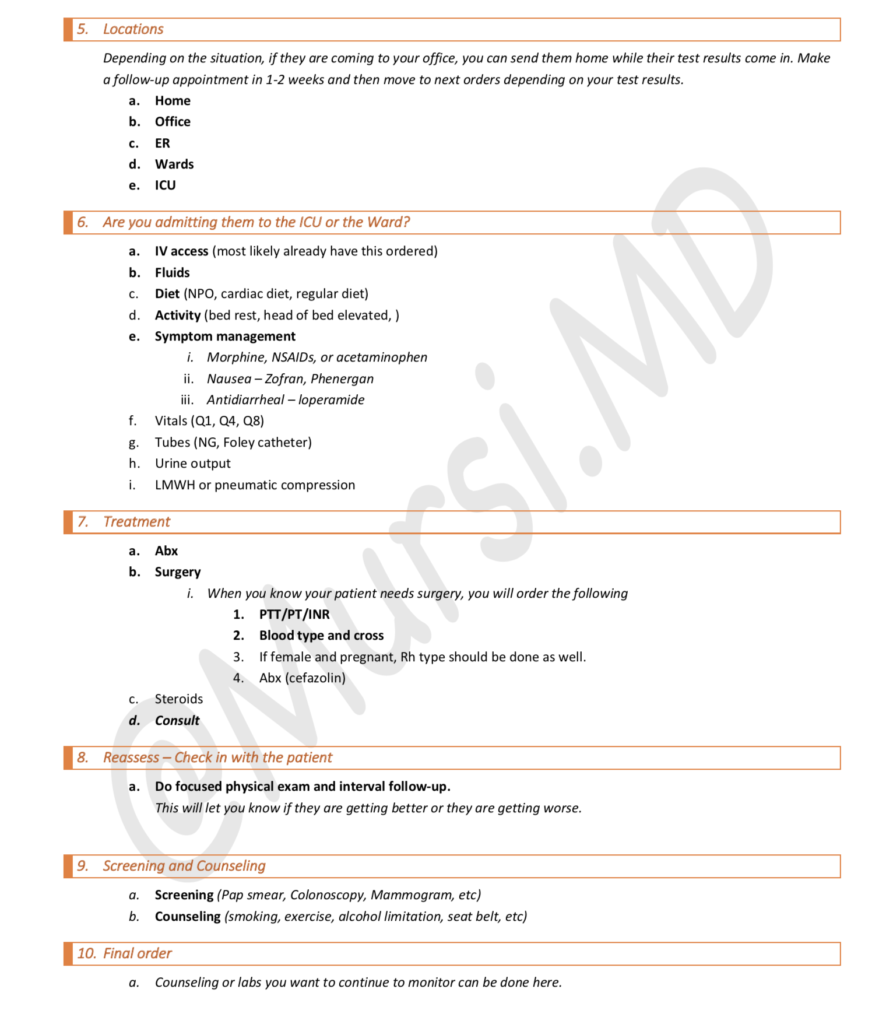Step 3 CCS Strategy
Studying for Step 3 CCS and you have no idea how to begin?
First you need a source. I personally use UWorld Step 3 CCS interactive cases to practice. You can purchase it on their website. To use it you must log in on your laptop/desk top and cannot not access it on your iPhone. Once you purchase and log in through their website, launch Step 3 CCS and then click on the “Interactive Cases” tab. This will present you with 51 cases. Launch the first one, and now you BEGIN!!
I created a schedule based around these cases. In 21 days you can get all of the 51 cases DONE (and over 900 UWorld questions)! Check out my YouTube video on Step 3 Study Schedule to get you set up and running. Or you can read about it here on my blog by clicking here.
Now, let’s begin on how to tackle Step 3 CCS cases.
You can also listen to me explain all of this in a YouTube video. Click here to watch my youtube video on Step 3 CCS Strategy!
The Strategy
1. Basic information
You are presented first with basic information on your patient. This includes age, gender, medical history, social history, etc. After reading the vitals and the thorough history of present illness you will already have a good idea what the potential diagnosis will be
2. Emergent or non-emergent?
After reading through the HPI, you must decide which one it is. If emergent, you need to do emergency orders before doing the physical exam. You give vital signs, and this will give you information on their hemodynamic stability.
Emergent (Life-threatening situation)
Pulse ox
Oxygen
IV access +/- NSS
+/- Cardiac monitoring
+/- BP monitoring
+/- EKG (12 -lead)
Non-emergent (not life-threatening): Directly go to physical exam
3. Physical exam
Complete physical exam:
— If stable and pt has a broad generalized signs and symptoms, do a complete physical exam.
Focused physical exam:
— If unstable, ALMOST ALWAYS FOCUSED. You do not want to waste your time doing unnecessary physical exam. You will get points taken off if you do complete when it is unnecessary and you cannot waste time.
— If stable and complaint is pretty focused to an organ system, then you do more focused exam. For example, pt comes in with what seems to be a UTI, then you are not going to need a breast exam, neuro exam completed.
4. Orders: Labs/Studies
Geared towards diagnosing and excluding differential diagnosis. You will either order them Stat or Routine. Depending on the emergency, you can decide which is necessary. Usually if in the ER, its Stat. At the office, it is usually Routine.
Images (US, XR, CT, MRI, Echo)
Blood work (CBC, BMP, Blood culture, TSH levels)
Urine (UA, Ketone, Urine toxicology)
Pregnancy (serum/urine b-HCG – qualitative vs quantitative)
Others (Cardiac enzymes, EKG, biopsies)
5. Locations
Depending on the situation, if they are coming to your office, you can send them home while their test results come in. Make a follow-up appointment in 1-2 weeks and then move to next orders depending on your test results.
Home
Office
ER
Wards
ICU
6. Are you admitting them to the ICU or the Ward?
If you are admitting them, then you must think of the following orders to always put in. Watch my YouTube Video on Step 3 CCS strategy where I talk about all of this.
IV access (most likely already have this ordered)
Fluids
Diet (NPO, cardiac diet, regular diet)
Activity (bed rest, head of bed elevated, )
Symptom management
— Morphine, NSAIDs, or acetaminophen
— Nausea – Zofran, Phenergan
— Antidiarrheal – loperamide
Vitals (Q1, Q4, Q8)
Tubes (NG, Foley catheter)
Urine output
LMWH or pneumatic compression
7. Treatment
This will depend on what is needed for that particular case. However, when you need to do surgery, you have to order specific orders prior to the surgery every time. And remember to consult the specific specialty before treatment is made, unless an empiric abx is required.
Surgery pre-op orders
PTT/PT/INR
Blood type and cross
If female and pregnant, Rh type should be done as well.
Abx (cefazolin)
8. Reassess – Check in with the patient
You will do an interval follow-up and a focused physcial exam to check in on the patient when they are admitted or when they return for a follow-up exam at your office. This will let you know if they are getting better or they are getting worse.
9. Screening and Counseling
Always look to see if you need to order any screening tests depending on the age and lifestyle. And in just about every single case you will counsel.
Screening examples: pap smear, colonoscopy, mammogram (etc)
Counseling examples: smoking, exercise, medication compliance, alcohol limitation, seat belt, etc.
And that is it you guys! This is a great check list to go through as you are doing the cases! It helps to get through the cases smoothly and making sure not to forget anything. You do not necessarily do all of this in this order. You might need to transfer them to the ER after they came in to the office before doing any orders, etc.
I am providing an image or pdf here for you guys in this post to save. You can use it to look at as you go through the cases and over time you should get the hang of it and do it without needing to look at it! A quick cheat sheet.


Best of luck!!!
Mursi

